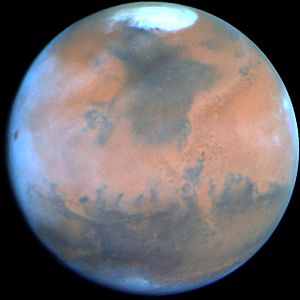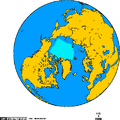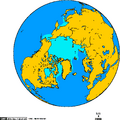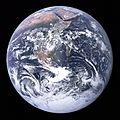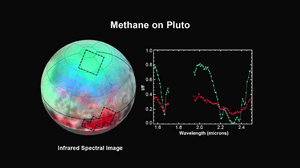Polar ice cap facts for kids
A polar ice cap is a very cold area at the top or bottom of a planet, dwarf planet, or moon. These areas are covered in ice. Think of them like giant frozen hats on a planet!
The ice in these caps can be made of different things. For example, Earth's polar caps are mostly made of water ice. But on Mars, the ice caps are a mix of frozen carbon dioxide (which is like dry ice) and water ice.
Polar ice caps form because the areas near the poles get much less sunlight than areas closer to the equator. This makes them super cold, so water and other gases freeze into ice.
Over long periods, these ice caps can grow or shrink. This happens because of climate changes or how a planet moves around the Sun. Even during a single year, the size of the ice caps can change with the seasons.
Contents
Earth's Polar Ice Caps
-
The amount of Arctic sea ice in September, from 1978 to 2002.
-
The Blue Marble, Earth as seen from Apollo 17. You can see the southern polar ice cap.
The North Pole: Arctic Ice
Earth's North Pole is covered by a huge sheet of floating sea ice over the Arctic Ocean. This ice is also called pack ice. Some parts of this ice never melt, even in summer. These parts can become very thick, up to 3–4 meters (about 10–13 feet) thick. Some ridges can be as tall as a six-story building!
The area covered by this sea ice changes. It can be between 9 and 12 million square kilometers (about 3.5 to 4.6 million square miles). Besides the sea ice, there's also the Greenland ice sheet. This is a huge sheet of ice on land, covering about 1.71 million square kilometers (about 660,000 square miles). It holds a massive amount of ice. When pieces of this ice break off, they form icebergs that float in the northern Atlantic Ocean.
Scientists at the National Snow and Ice Data Center have been watching the Arctic ice. They found that since 1979, the amount of sea ice in winter has shrunk by about 4.2 percent every ten years. This means less ice is forming each winter.
The South Pole: Antarctic Ice
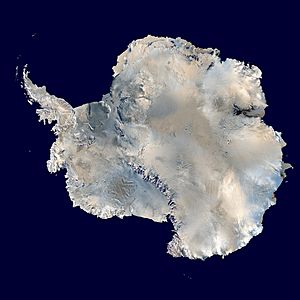
Earth's South Pole is on the continent of Antarctica. It is covered by the Antarctic ice sheet, which is the largest single mass of ice on Earth. This ice sheet covers about 14.6 million square kilometers (about 5.6 million square miles). It holds a huge amount of ice, between 25 and 30 million cubic kilometers. That's about 70% of all the fresh water on Earth!
Unlike the Arctic, the sea ice around Antarctica has actually grown slightly over the last three decades (from 1979 to 2009). However, the land ice on Antarctica is still being studied closely.
Changes in Earth's Ice Caps
Over the last few decades, Earth's polar ice caps have gotten a lot of attention. This is because of how much they are changing. NASA reports that since the late 1970s, the Arctic has lost a lot of sea ice each year. At the same time, the Antarctic has gained some sea ice.
Scientists use ice cores to learn about past climates. These are long tubes of ice drilled from the ice caps. They contain tiny bubbles of air from thousands of years ago. By studying these bubbles, scientists can see how much carbon dioxide and methane were in the air back then. This helps them understand how Earth's climate has changed over time.
In recent years, the Arctic sea ice has shrunk to its smallest sizes ever recorded. This rapid decline shows how important it is to keep studying our planet's ice caps.
Mars's Ice Caps
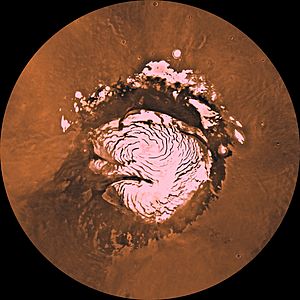
Besides Earth, the planet Mars also has polar ice caps! They are mostly made of water ice, with a little bit of dust mixed in. The very bottom layer of the south polar cap is made of frozen carbon dioxide.
On Mars, a layer of frozen carbon dioxide forms in winter in both the north and south poles. Then, in spring, this frozen carbon dioxide turns directly into a gas. This process is called sublimation.
Scientists have studied Mars's ice caps using data from NASA missions. They found that the southern ice cap changes in size from year to year. The most common idea for why this happens is that small changes in Mars's orbit around the Sun cause these changes.
Pluto's Ice Cap
In 2015, NASA's New Horizons mission discovered something that looked like a polar ice cap on the dwarf planet Pluto. When the probe flew past Pluto in July 2015, its instruments confirmed it was indeed an ice cap. This ice cap is made of frozen methane and nitrogen ices. How cool is that!
See also
 In Spanish: Casquete polar para niños
In Spanish: Casquete polar para niños


